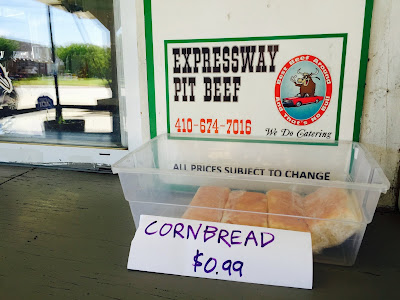It’s a question for the ages, and for many of us in the food world, a proverbial hermeneutic Gordian knot of epicurean semiotics and vexation, whose elucidation often seems as enigmatic and ultimately unknowable as that final, all-too-distant digit of Pi. Men have fought over the question. Marriages have ended because of it. And the food press has debated the issue with a rancor and invective usually reserved for the most politically binary questions of national identity and matters of state.
The question I’m talking about: is Baltimore's pit beef actually barbecue?
For the uninitiated, a quick note of explanation: pit beef is made of minimally-seasoned top round (that’s the rear leg of the cow, yo), usually grilled over charcoal—not smoked—then sliced, deli-thin on an I’ll-take-your-fingers industrial slicer, and served, medium rare, atop a Kaiser roll. Baltimore’s pit beef is many things. It’s emphatically local. It’s insistently sauceless. And it’s ferociously working class. Many familiar with its charms have even gone so far as to call pit beef their favorite kind of barbecue.
But is pit beef actually barbecue?
To know Baltimore is to know (intuitively, at least) the answer to that question. Baltimore is the wackadoodle yen to sister-city (and just 40-miles to the south) Washington, D.C.’s buttoned-up yang. But the city is an object of deep and abiding adoration for me, and the once-home to heroes of mine. Fitzgerald lived—and drank—there. Poe drank and died there. A few years ago, I filmed an episode of Netflix’s House of Cards there (Season 3, Episode 3, in case you’re wondering), and once, well before that, very nearly got into a fistfight with Cry Baby-era Iggy Pop at Baltimore’s infamous 8 X 10 Club during a Joe “Don’t Mess with My Duck Tail” Clay show (though that story will have to wait for another time and place, friend-o).
Baltimore is where Washingtonians go to let their hair down and their freak flags fly. Baltimore is a John Watersian bizarro world of rococo cultural and culinary oddities—think Frank Zappa; think of the mighty and gender-bending Divine—where the Four C’s of local gastronomy reign supreme: coddies (puck-like cakes of salt cod and potato), crab cakes, corned beef, and chocolate tops (cookies coronated with crowns of chocolate frosting). But arch among these deeply unctuous gastronomic curios is Baltimore’s divisive take on barbecue: the venerable pit beef sandwich.
To settle this is-it-or-is-it-not-barbecue debate (in my own mind at least, and for all the perpetuity it would take for me to digest my sandwich) I visited the don’t-blink-or-you’ll-miss-it Expressway Pit Beef (of the “Beef “Stand” as locals call it) in Odenton, Maryland, about thirty-minutes outside Charm City, but at the very epicenter of Maryland’s pit beef country. Expressway is a function-over-form kind of place, contiguous to an Ace Hardware store, and, not surprisingly, egalitarian in the extreme. Walk up to the “order” window. Order. Pay. And wait. After a few moments of sunshine, car noise, and birdsong, your food—in my case, a pit beef sandwich with a side of house-made fries—is unceremoniously slid from out of the “pick up” window for you—and for you only—to adorn with the requisite and don’t-even-think-about-skipping-these pit beef condiments of horseradish, malt vinegar, and Baltimore’s very own Old Bay seasoning; a holy trinity of added flavor if there ever was one. You then sit at a plastic picnic table outside the beef stand and eat. Simple enough, right? But what comes next is anything but familiar. Because nothing is quite routine about what happens inside your mouth when you bite into a pit beef sandwich. For what comes with the actual eating part of this transaction is a culinary epiphany and a lesson in gastronomic minimalism wherein we learn that two simple ingredients—meat and bun—can be transformative in our lives as eaters in ways that make us more perceptive to nuance in textures and the slightest gradations in flavor. The pit beef of Expressway Pit Beef is wonderfully delicious. It’s more than delicious, actually: it’s revelatory in its pure and unadulterated “beefiness” and it teaches those eaters astute enough to pay attention all that beef—simply prepared and left well enough alone—can be. I love the pit beef of Expressway. My adoration for their no-fuss, Charm City charm is keen.
But the question yet remains: is pit beef actually barbecue?
My answer, in a word: NO. It’s not. Emphatically so.
Because what is missing from the litany of pit beef’s ingredients and processes is the one primary and irrefutably essential component to barbecue that makes barbecue, well, barbecue. And that one missing ingredient: time. As any pit master will tell you, time is the low-and-slow ritual of culinary supplication by which the dissolution of connective tissue and fat is petitioned and teased out from meat for the truly deserving from those all-too-fickle gastronomic gods of flavor through the sacramental imploration of wood smoke and fire. Without time as an ingredient, cooking meat over fire is just…grilling.
But so what if pit beef isn’t actually barbecue? Who really cares? Baltimore doesn’t care. That much is sure. Baltimore has always been, and still remains, proudly immune from the too-cool-for-school castigations and food envy of other American cities; it’s utterly impervious to the culinary judgement of visiting food nerds. Baltimore gives no fucks that pit beef isn’t considered “real” barbecue outside the city, and neither should you. Eat it. Enjoy it on its own terms and for what it really is. Because what Baltimore’s pit beef really is is really, really good.
Your link: Expressway Pit Beef






